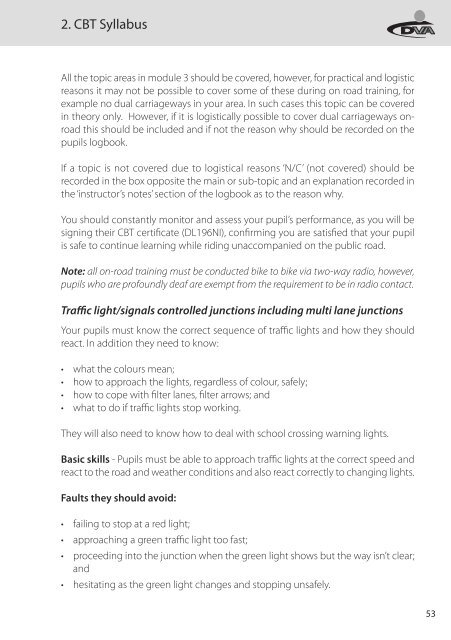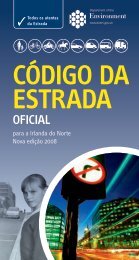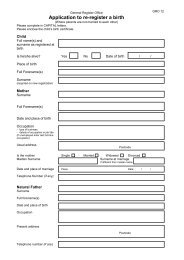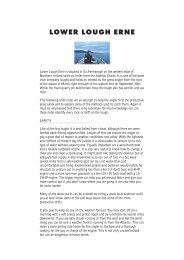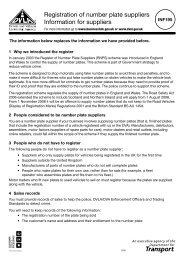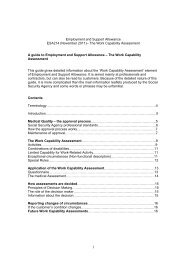an instructors guide to delivering compulsory basic training - NIDirect
an instructors guide to delivering compulsory basic training - NIDirect
an instructors guide to delivering compulsory basic training - NIDirect
You also want an ePaper? Increase the reach of your titles
YUMPU automatically turns print PDFs into web optimized ePapers that Google loves.
2. CBT Syllabus<br />
All the <strong>to</strong>pic areas in module 3 should be covered, however, for practical <strong>an</strong>d logistic<br />
reasons it may not be possible <strong>to</strong> cover some of these during on road <strong>training</strong>, for<br />
example no dual carriageways in your area. In such cases this <strong>to</strong>pic c<strong>an</strong> be covered<br />
in theory only. However, if it is logistically possible <strong>to</strong> cover dual carriageways onroad<br />
this should be included <strong>an</strong>d if not the reason why should be recorded on the<br />
pupils logbook.<br />
If a <strong>to</strong>pic is not covered due <strong>to</strong> logistical reasons ‘N/C’ (not covered) should be<br />
recorded in the box opposite the main or sub-<strong>to</strong>pic <strong>an</strong>d <strong>an</strong> expl<strong>an</strong>ation recorded in<br />
the ‘instruc<strong>to</strong>r’s notes’ section of the logbook as <strong>to</strong> the reason why.<br />
You should const<strong>an</strong>tly moni<strong>to</strong>r <strong>an</strong>d assess your pupil’s perform<strong>an</strong>ce, as you will be<br />
signing their CBT certificate (DL196NI), confirming you are satisfied that your pupil<br />
is safe <strong>to</strong> continue learning while riding unaccomp<strong>an</strong>ied on the public road.<br />
Note: all on-road <strong>training</strong> must be conducted bike <strong>to</strong> bike via two-way radio, however,<br />
pupils who are profoundly deaf are exempt from the requirement <strong>to</strong> be in radio contact.<br />
Traffic light/signals controlled junctions including multi l<strong>an</strong>e junctions<br />
Your pupils must know the correct sequence of traffic lights <strong>an</strong>d how they should<br />
react. In addition they need <strong>to</strong> know:<br />
• what the colours me<strong>an</strong>;<br />
• how <strong>to</strong> approach the lights, regardless of colour, safely;<br />
• how <strong>to</strong> cope with filter l<strong>an</strong>es, filter arrows; <strong>an</strong>d<br />
• what <strong>to</strong> do if traffic lights s<strong>to</strong>p working.<br />
They will also need <strong>to</strong> know how <strong>to</strong> deal with school crossing warning lights.<br />
Basic skills - Pupils must be able <strong>to</strong> approach traffic lights at the correct speed <strong>an</strong>d<br />
react <strong>to</strong> the road <strong>an</strong>d weather conditions <strong>an</strong>d also react correctly <strong>to</strong> ch<strong>an</strong>ging lights.<br />
Faults they should avoid:<br />
• failing <strong>to</strong> s<strong>to</strong>p at a red light;<br />
• approaching a green traffic light <strong>to</strong>o fast;<br />
• proceeding in<strong>to</strong> the junction when the green light shows but the way isn’t clear;<br />
<strong>an</strong>d<br />
• hesitating as the green light ch<strong>an</strong>ges <strong>an</strong>d s<strong>to</strong>pping unsafely.<br />
53


